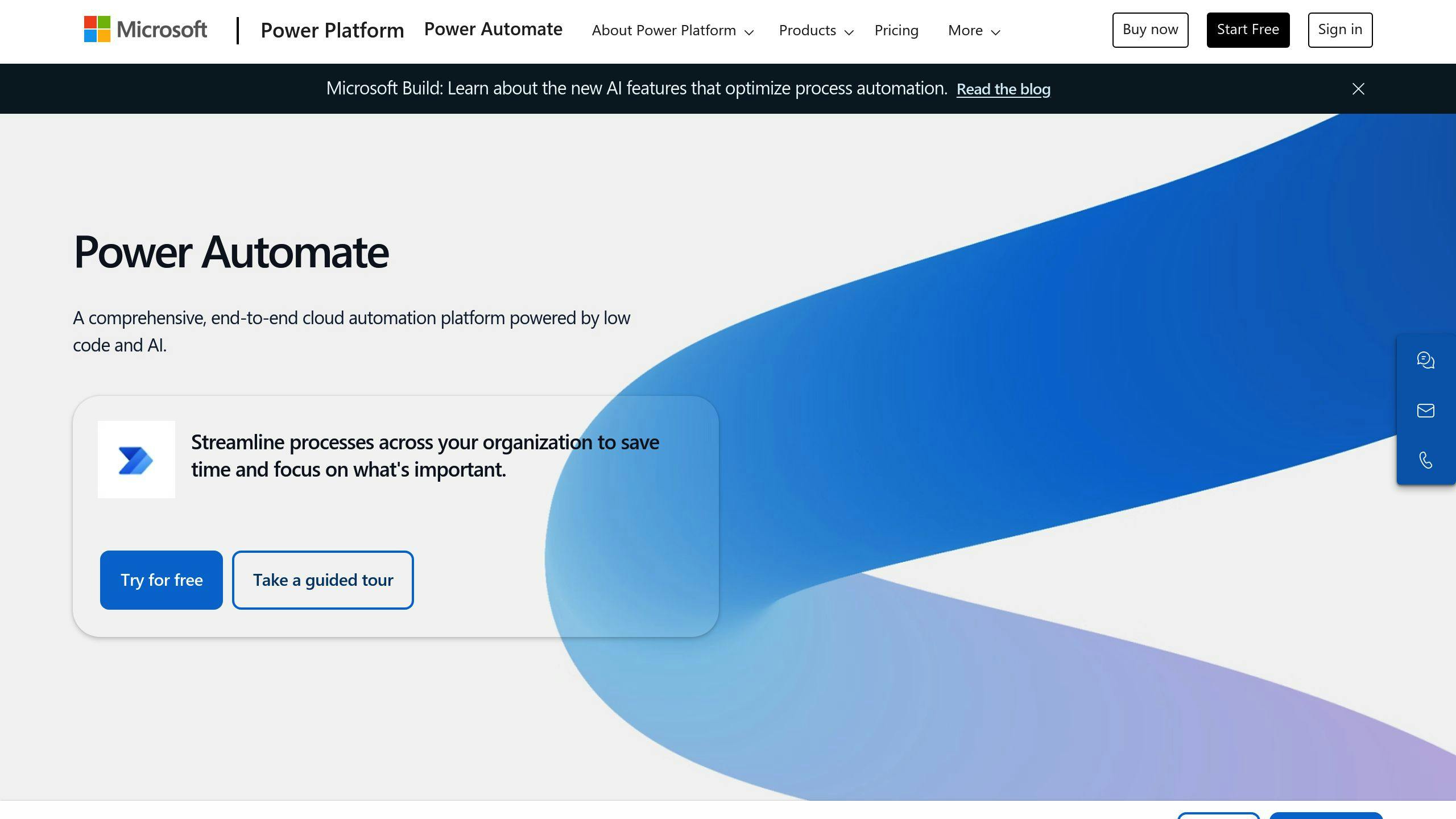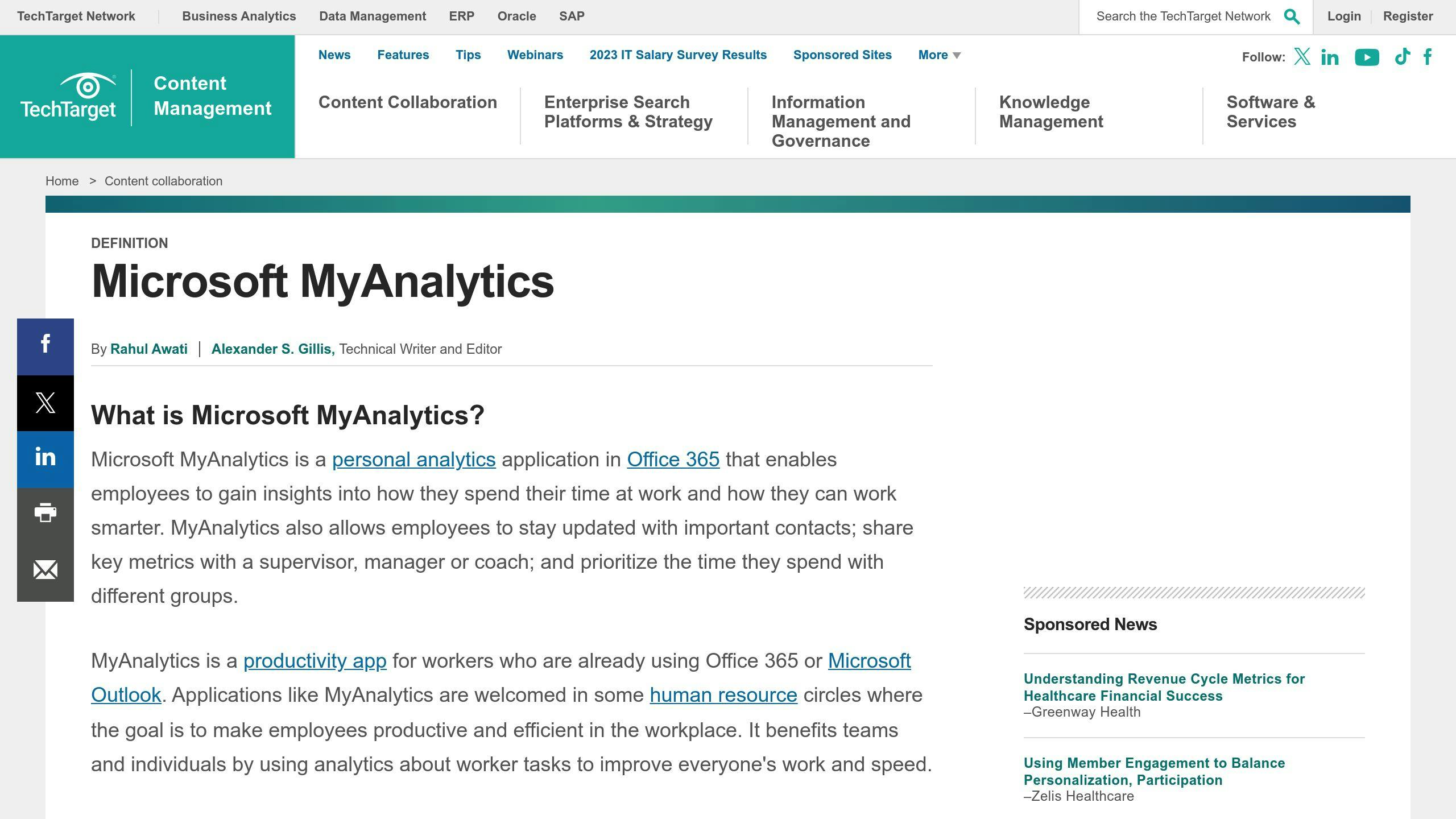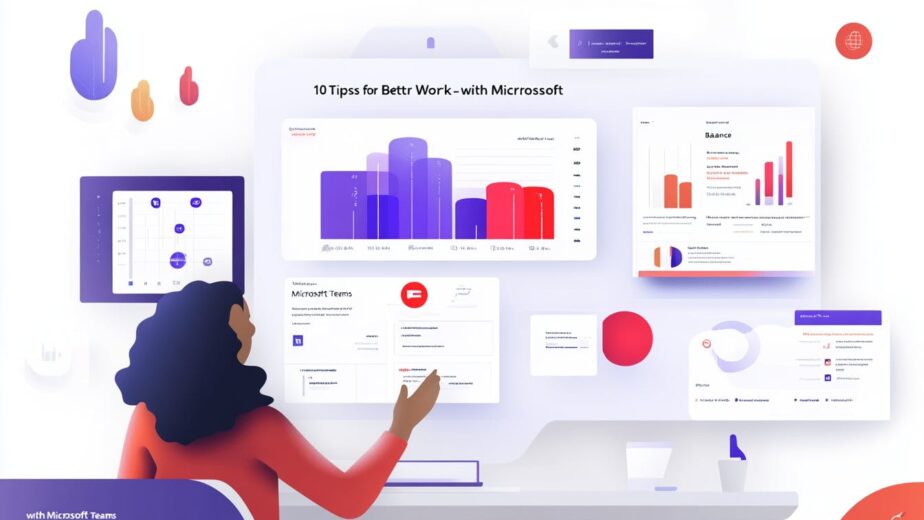Struggling to separate work and personal life while using Microsoft Teams? Here’s how to regain control:
- Set work boundaries
- Make time for focused work
- Improve team communication
- Use async communication
- Plan meetings better
- Create a work-home transition
- Manage tasks in Teams
- Build team connections
- Automate regular tasks
- Practice digital health
Quick comparison of key features:
| Feature | Purpose | How to Use |
|---|---|---|
| Work Hours | Set availability | Profile settings > Privacy |
| Focus Time | Block uninterrupted work | Viva Insights > Start daily focus plan |
| Do Not Disturb | Mute notifications | Type /dnd or click profile pic |
| Virtual Commute | End workday routine | Viva Insights > Virtual Commute |
| Power Automate | Automate tasks | Apps > Power Automate > New Flow |
These tips help you use Teams more effectively without letting it take over your life. Start with one or two, then build up. Remember: it’s about finding what works for you to stay productive without burning out.
Related video from YouTube
1. Set Work Boundaries
Want to keep your work and personal life separate on Microsoft Teams? Here’s how:
Set Your Work Hours
Microsoft Teams is rolling out a new Work Hours and Location (WHL) feature. It’s simple to use:
- Go to profile settings
- Find "Working hours" in privacy
- Toggle it on
- Set your schedule
- Save
"Without them, you could easily work all day every day—and no one would be happy about it." – Microsoft 365 Team
Adjust Your Notifications
Don’t let work bug you after hours:
- Customize alerts in Settings > Notifications
- Use "Quiet hours" on mobile to silence notifications
Use Status Messages
Let others know when you’re available:
- Click your profile picture
- Choose "Set status message"
- Type your message
- Set duration
Example: "Busy with a deadline, will respond ASAP."
Keep your status updated. It’s an easy way to manage expectations.
2. Make Time for Focused Work
Remote work can make it tough to find quiet time. But don’t worry – Microsoft Teams has your back.
Schedule Focus Time
Want to block out time for deep work? Here’s how:
- Open Viva Insights
- Click "Start a daily focus plan"
- Pick your times
Boom! You’ve got up to 2 hours of focus time each day, working around your other meetings.
Turn On Do Not Disturb
Need to concentrate? Use Do Not Disturb:
- Type
/dndin the search bar - Or click your profile pic and choose "Do not disturb"
This blocks notifications, except from your VIPs.
"Setting your status to do not disturb lets your coworkers know you’re not available." – Nick Brazzi, LinkedIn Learning Instructor
Let Others Know When You’re Free
Keep your team in the loop:
| What to do | How to do it |
|---|---|
| Set a status message | Profile picture > "Set status message" |
| Add VIP contacts | Settings > Privacy > Manage priority access |
Don’t forget to update your status regularly. Your team will thank you!
3. Improve Team Communication
Good communication is vital for work-life balance. Here’s how to use Teams effectively:
Organize Your Workspace
Keep things tidy:
- Cap channels at 200 per team
- Use clear names (e.g., "finance-budgeting")
- Add channel descriptions
- Pin important ones, hide unused ones
Pro tip: Create a "water cooler" channel for casual chats.
Smart @Mentions
Don’t go overboard with notifications:
| Do | Don’t |
|---|---|
| @mention for urgent stuff | Tag everyone for minor updates |
| Use @channel for team news | @mention in every message |
| Check availability first | Ignore status messages |
Set Clear Guidelines
Make rules for your team:
1. Pick the right tool
| For | Use |
|---|---|
| Quick questions | Chat |
| Team updates | Channel posts |
| Detailed info | |
| Group talks | Video calls |
2. Set response times
- Urgent: 1 hour
- Important: Same day
- Regular: 24 hours
3. Respect off-hours
- Delay after-hours messages
- Use "Do Not Disturb" for focus time
4. Use Async Communication
Async communication in Teams can help you balance work and life. Here’s how:
Choose Between Chat and Email
Pick the right tool:
| Teams Chat | |
|---|---|
| Quick questions | Formal approvals |
| Team updates | Official announcements |
| Casual chats | Detailed reports |
| Real-time collaboration | External communication |
Share Video Messages
Video messages add a personal touch:
- Record 60-second clips in Teams
- Use for quick updates or explanations
- Click the video icon to record
- Trim before sending
"I rarely rely on email myself…I tend to send a [Microsoft] Teams message, or even WhatsApp if it’s really urgent." – Farhad Divecha, Managing Director of Accruracast
Work Together on Shared Documents
Collaborate without constant meetings:
1. Share files in Teams channels
Upload documents and @mention teammates for input.
2. Use co-authoring features
Edit together in real-time and leave comments for feedback.
3. Set clear deadlines
Use Teams’ task features to assign due dates and follow up in channel conversations.
5. Plan Meetings Better
Want to boost your work-life balance? Master meeting management in Microsoft Teams. Here’s how:
Have Meeting-Free Days
Block out entire days for deep work:
- Mark your Outlook calendar
- Set up a recurring "Busy" event
- Let your team and clients know
Big companies are doing it. Facebook? "Meeting-Free Wednesdays" since 2020. Citi? No video meetings on Fridays.
"The blurring of lines between home and work and the relentlessness of the pandemic workday have taken a toll on our well-being. It’s simply not sustainable." – Jane Fraser, Citigroup CEO
Keep Meetings Short and Focused
Make meetings count:
- Clear agenda, stick to it
- Only invite who’s needed
- Use a timer
- Start on time, skip the chit-chat
Pro tip: Use Outlook’s "shorten appointments and meetings" feature. It’ll end meetings early or start them late automatically.
Use Teams’ Scheduling Assistant
This tool is a game-changer:
| Feature | Benefit |
|---|---|
| Availability Check | No more conflicts |
| Meeting Suggestions | Find the perfect time |
| Invitation Sending | Quick and easy |
To make it work for you:
- Keep your calendar current
- Use Availability View to spot free times
- Sync with Outlook for smooth scheduling
sbb-itb-8be0fd2
6. Create a Work-Home Transition
Working from home can make it hard to separate your job from your personal life. Here’s how Microsoft Teams’ Virtual Commute feature can help:
Set Up Virtual Commute
- Open Viva Insights in Teams
- Click the ellipsis (…)
- Select "Virtual Commute" from the left menu
- Enroll in the feature
This tool helps you:
- Close out today’s tasks
- Set reminders for unfinished work
- Preview tomorrow’s schedule
- Reflect on your day
Add Mindfulness to Your Routine
Microsoft teamed up with Headspace to offer meditation sessions at the end of your virtual commute. Why? Because mindfulness can boost your focus and cut down on stress. It’s a great way to switch from work mode to personal time.
"The virtual commute will help you wrap up your tasks at the end of the workday, prepare for tomorrow, and transition into your personal time with peace of mind." – Jared Spataro, Corporate Vice President for Microsoft 365
Switch from Work to Personal Mode
End your workday clearly:
| Action | Purpose |
|---|---|
| Close work apps | End work tasks |
| Change your clothes | Shift your mindset |
| Take a short walk | Mimic a commute |
Pro tip: Use Microsoft’s "quiet time" feature to mute Teams and Outlook notifications after hours.
7. Manage Tasks in Teams
Teams has built-in task management tools. Here’s how to use them:
Add To Do and Planner
- Click "…" in Teams’ left nav
- Search "Tasks by Planner and To Do"
- Add the app
Now you’ve got personal and team tasks in one spot.
Create Tasks in Channels
In a channel:
- Click ‘+’ for a new tab
- Pick ‘Planner’
- Make tasks, set deadlines, assign people
Pro tip: Use Board View to group tasks by stage (Planning, In Progress, Review).
Track Progress
| View | What It Shows |
|---|---|
| My Tasks | Your tasks (including from Planner) |
| Shared Plans | Team channel plans |
| List View | Filter by status, due date, etc. |
| Schedule View | Calendar view of tasks |
For a quick look:
- Open Planner in Teams
- Check "My Day" for today’s tasks
- See "My Tasks" for all your assignments
Using these tools helps you manage work better. It’s crucial, given this stat:
"80% of global knowledge workers report feeling overworked and close to burnout."
With Teams’ task features, you can organize, prioritize, and avoid feeling swamped.
8. Build Team Connections
Remote work can be isolating. Here’s how to use Microsoft Teams to keep your team close:
Virtual Coffee Breaks
Set up casual 15-30 minute video calls for non-work chats. It’s like grabbing coffee at the office.
Quick tips:
- Schedule weekly or bi-weekly
- Keep it optional and chill
- Use video
- BYO drink and snack
Non-Work Channels
Create Teams channels for hobbies or fun chats. Let people bond over shared interests.
Try these:
- Book club
- Pet photos
- Recipe sharing
- Fitness challenges
Remote Team-Building
Use Teams for virtual activities that bring people together:
| Activity | How It Works | Why It’s Great |
|---|---|---|
| Virtual Scavenger Hunt | Find items at home based on prompts | Gets people moving and laughing |
| Kahoot! Trivia | Live trivia games through Teams | Sparks friendly competition |
| "Guess the Team Member" | Share fun facts, others guess who | Helps team learn about each other |
The goal? Help your team connect personally. It leads to better teamwork and job satisfaction.
"53% of remote workers say the lack of face-to-face interaction makes them feel disconnected from their coworkers." – Buffer’s 2021 State of Remote Work report
9. Automate Regular Tasks
Sick of doing the same stuff over and over? Let’s put Teams to work for you.
Power Automate: Your New Best Friend

Power Automate is like a robot assistant for Teams. Here’s how to use it:
- Open Teams, go to Apps
- Find "Power Automate"
- Hit "+New Flow"
Try these:
- Get emails when you’re mentioned
- Save key messages to OneNote
- Set up meetings without leaving Teams
Bots: Your Digital Helpers
Bots can do tasks for you. Some cool ones:
- Standuply: Runs surveys, manages to-dos
- Todoist: Turns chats into tasks
- YellowAnt: Links with 40+ apps
Adding a bot? Just search and click "Add" in the Teams app store.
Make Repetitive Tasks Disappear
| Task | How to Automate | Why It’s Great |
|---|---|---|
| Approvals | Use Approvals workflow | Handle requests in Teams |
| Event alerts | Set up Zapier | Get Teams messages for new sign-ups |
| Create tasks | Use Flow bot | Turn chat into tasks |
"The Flow bot lets you make custom flows. Like getting an email when someone @mentions you in a specific way."
10. Practice Digital Health
In today’s always-on world, it’s key to keep a healthy balance with tech. Here’s how to use Microsoft Teams without burning out:
Use MyAnalytics

MyAnalytics shows you how you spend your time at work. It tracks:
- Emails
- Meetings
- Teams calls and chats
- OneDrive and SharePoint docs
Check your dashboard to spot patterns. You might find you’re in too many meetings and not doing enough focused work.
Take Tech Breaks
Too much screen time isn’t good for you. Try these:
- Use the 20-20-20 rule: Every 20 minutes, look at something 20 feet away for 20 seconds.
- Start meetings 5 minutes late. Use this time to stretch.
- Set reminders for breaks and meals.
For some meetings, you can:
| Meeting Type | What You Can Do |
|---|---|
| Audio-only | Walk outside |
| Team check-in | Move around your room |
| One-on-one | Use Teams mobile app and walk |
Promote Healthy Habits
Get your team on board:
- Set tech-free times
- Take a short walk before and after work
- Use screen time tools on your devices
A Gallup study found that two-thirds of full-time workers feel burned out. By using tech smartly, we can fight this trend and feel better overall.
Conclusion
Microsoft Teams has exploded in popularity. From 75 million daily users in April 2020 to 145 million in April 2021. That’s HUGE growth.
But here’s the thing:
More users doesn’t always mean better work-life balance. In fact, it can make things worse if you’re not careful.
So what can you do?
Start small. Pick one or two tips from this article and try them out. Maybe you:
- Set clear work hours
- Tweak your notification settings
Once those feel natural, level up. Use MyAnalytics to track your work habits. Or create Power Automate flows to cut down on busywork.
Remember: Your company plays a big role too. With 74% of companies planning to keep more employees remote (according to a Gartner CFO survey), they need to step up.
How? By:
- Checking in on employee stress levels
- Encouraging breaks
- Offering flexible hours
The key is finding what works for YOU. Experiment, adjust, and find your sweet spot for productive remote work without burning out.
